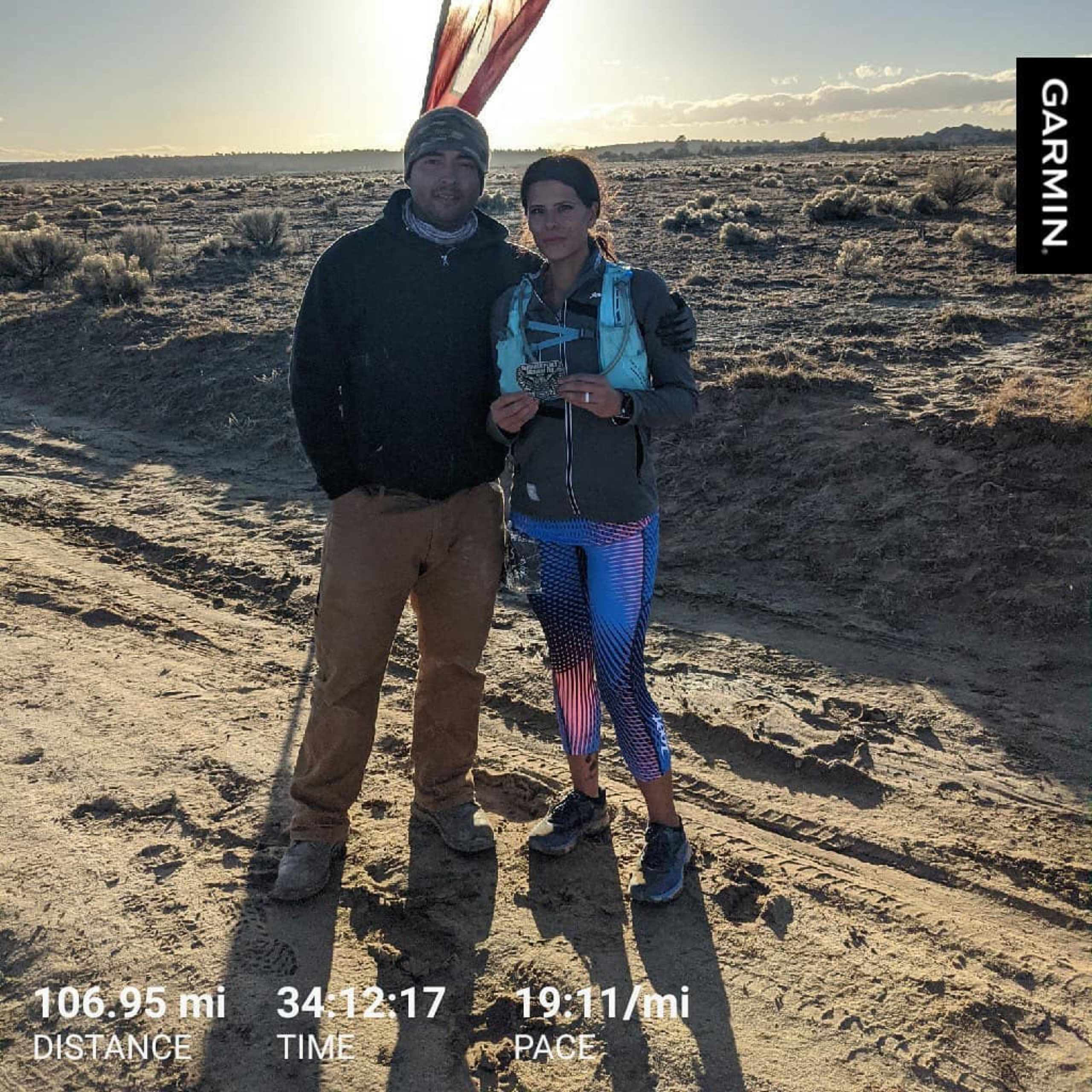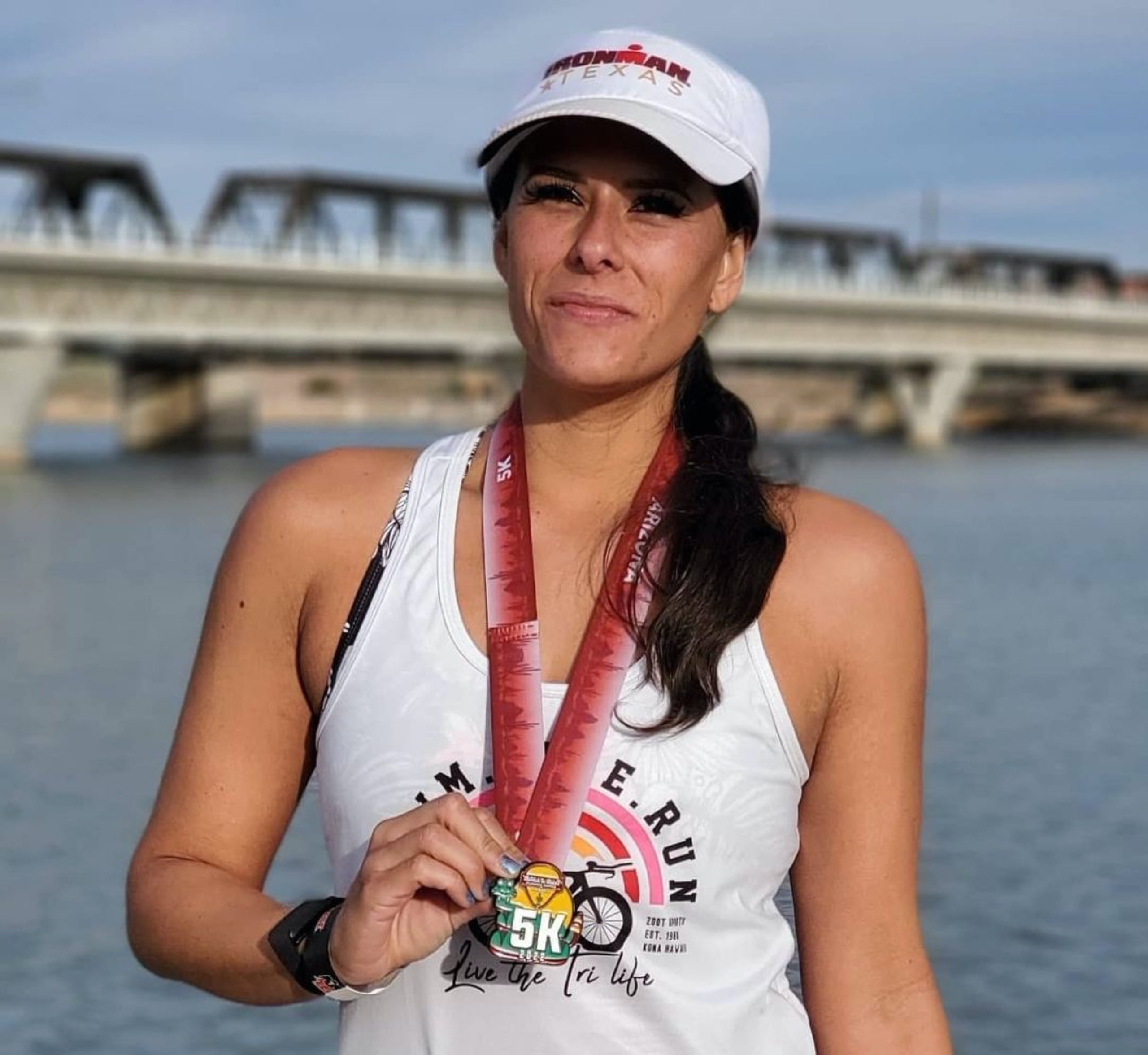From Couch to … 170k
Triathlon AgeGrouper Sabrina Somarribas shares lessons and learnings from her path from 5k to Ironman Triathlons and 100 mile Ultra Marathons

In 2019, Sabrina Somarribas and eleven others toed the line in Cuba, New Mexico, preparing to run the Deadman Peaks Backbone 106 mile ultra. Over the next 34 hours and 14 minutes, Sabrina would put her training to the test and submit herself to the ultimate challenge of mind, body and will.
“I was the last one out there. Alone. In severe pain with every step,” said Sabrina. “I had swollen ankles, knees, and fingers. At one point, it felt like I was going in circles and never getting closer.” She recalls running through the night, through the cold, the rain and the wind. She fought off sleep with every step.
“The last 18 miles took me to a place where I had to dig deeper than I ever had before. With not a soul around, I kept saying to myself ‘just one foot in front of the other.’ If I took a DNF (Did Not Finish) I knew I would never let myself live it down.”
Sabrina crossed the finish line in just under 35 hours, with only 16 minutes to spare before hitting the cut off. She earned her spot as one of only five finishers.

Previously, Sabrina ran marathons and completed full Ironman distance triathlons. That day, she added ultra-marathoner to her resume. “This race taught me that there is a fight inside of me that I didn’t know that I had.”
For those who see marathons, Ironman triathlons and ultras as an unattainable feat, you’ll want to keep reading before deciding you CAN’T do something. Sabrina started out like most of us did, small, really small, 5k small.
“Don’t let the intimidation get to you. If you have that little piece of you that wants to try, just do it. Get out of your comfort zone and just start training.”
As a certified triathlon coach, Sabrina is dedicated to helping others find success in the sport that has changed her life for the better. Through her training over the years, she has learned many valuable key lessons and takeaways. She shares them here to help others reach their goals and prove to themselves that they can do anything they set their mind too.
Rewind to the Beginning
Sabrina is the first to admit that she did not grow up an athlete. “I struggled with my weight into adulthood and wasn’t as active as I would have liked to be.”
In 2016, she was at her heaviest and knew something had to give. She found a local 5k and registered. She trained daily and once she crossed the finish line, she knew this was just the first of many races that she would complete. She dove head first into training and eventually, she was ticking off half and full marathons from the list.
“I found balance with my physical health when I found endurance sports.”
Sabrina shared, “Get out there and start small. Identify a goal and start chipping away at it. Listen to that voice in your head that says you are ready for a change.“
Training Smarter, Not Harder
Sabrina started out by training herself. In the beginning, her training plan was to simply go out and complete the distances day in and day out. There were no variations in efforts or intensities and no structured workouts with rests built-in.
“There are so many athletes I see that just go out and run as much as they can, as fast as they can, just so it looks good on Strava.” At first, she was one of these athletes.
She focused on accomplishing distance goals each week that aligned to her races. She picked big races, and put up big miles. At her peak, she was running 70 miles per week. That approach was met with injuries from over training, most notably, Achilles tendonitis and shin splints.
She has since implemented the 80/20 rule: 80% of training is easy/aerobic and 20% is hard/anaerobic. This approach has helped her manage her recovery and allowed her to remain less injury-prone.
“Train smart. Rest and recovery are as important as the training itself. Be disciplined and listen to your body.”

Running On Empty
Another key learning she picked up during those first few months and years was the importance of nutrition.
“One very important aspect that I neglected altogether when I started was what we call the fourth discipline, and that was nutrition. Not having that dialed in got the best of me during my first Ironman.”
“My first Ironman was Boulder in 2019. The only nutrition I had on the bike was chews which were a lot of sugar. By the time I got to the run, my stomach was bloated and cramping. I had to walk the first couple miles.”
Dialing in nutrition is a work in progress, but she is happy with what she has been doing.
“Now I take a gel at T1. Once on the bike, I take 50 to 70 grams of carbohydrates per hour. For electrolytes, I use Gatorade endurance which for me is around 2.5 to 3 bottles. I also use base salt on the run as well as gels at the same carb ratio.”
“The key is to develop an effective nutrition strategy for race day, and start dialing it in as soon as you begin training. Research different options and find things that work for you.”
Structuring Your Build to Your ‘A’ Race
“My training plan is broken down into different mesocycles: Preparation Phase, Competition Phase and Transition Phase. Within these mesocycles are microcycles which allow me to break down different objectives/variables for each discipline so that there is a purpose for each.”
Preparation Phase
This is all about preparing the body to be able to take on the heavy training load that will come as the race gets closer. Think of it as “training your body to be able to train”. This phase is essential if you plan to compete in long distance races.
The preparation phase includes very easy and very hard training–sticking to the 80/20 split, respectively. It also includes a focus on strength training. Sabrina says, “strength training is now a fixed part of the routine.” It is key for boosting performance and preventing injury.
Competition Phase
In this phase, much of your training will be focused on race prep. It will be more “pyramidal” in that many of your workouts will be completed at race pace. Here, you prepare the body to perform at those race-level efforts.
Typical workouts will include tempo runs/rides (efforts that are just slightly above your target race pace) as well as race pace intervals.
Preparing your body for the race conditions is key. If the event conditions are hot and humid then you must simulate this in your triathlon training program.
Transition Phase
Unlike the other phases, this segment is focused on transitioning an athlete from the mental high of training → completing a big “A” race → recovery.
“Athletes can feel down after accomplishing a big goal,” says Sabrina. Post-race blues can be quite severe for some, so planning for it will allow athletes to get the most out of their racing experience.
Sabrina also incorporates multiple races into her training to give her more exposure to the race day experience. “Not every race needs to be a race,” she says. Sometimes it’s helpful to use a race as a change of scenery for a training run, ride, or triathlon.
Finally, having a set plan for recovery time and a schedule to get back into training is also helpful. This helps athletes with a structured training regimen view post-race recovery as part of their larger training plan.
“Identify a training plan that works for you. The goal is to build endurance and avoid injury. Incorporate strength training. Simulate race day and embrace recovery segments of training. For those who want to compete and train year over year, view your training as a 365 day plan.”

